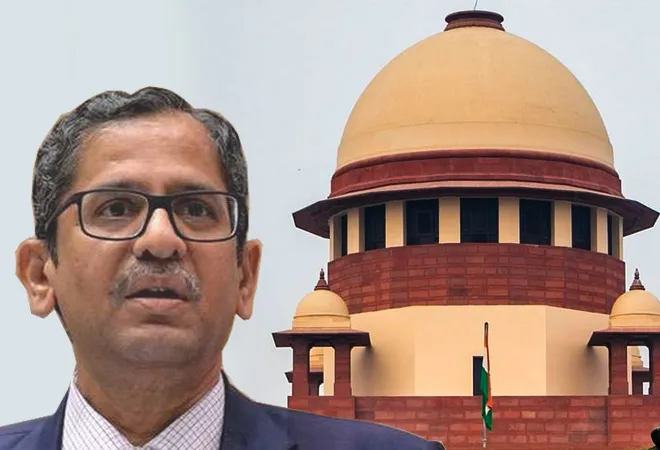
Ever since he took over the mantle as the Chief Justice of India (CJI), N.V. Ramana has been crusading to strengthen India’s ailing judicial infrastructure. In this regard, Justice Ramana has come out with a proposal to set up a National Judicial Infrastructure Corporation to speed up the execution of infrastructural projects at the lower judiciary (District Courts). His main contention has been that the Centrally Sponsored Scheme (CSS) for Development of Infrastructure Facilities for District and Subordinate Judiciary has failed to live up to the expectations notwithstanding increased monetary allocations by the Centre. This short article is an attempt to understand why a straightforward flagship scheme aimed at strengthening judicial infrastructure has failed to deliver.
Rationale behind the Scheme
The Centrally Sponsored Scheme (CSS) for Development of Infrastructure Facilities for Districts and Subordinate Judiciary has been in force since 1993-1994. The central scheme was devised to address the justice delivery needs in the aftermath of India’s economic liberalisation in 1991. Planned and operated by the Ministry of Law and Justice, the scheme mandates financial help by the Centre to the States and Union Territories for construction of court halls and residential units for judicial officers and judges of the district and subordinate courts. The method that the funding plan currently uses is divided on a ratio of 60:40 between the Centre and the State. The funding pattern is 90:10 for North Eastern and the Himalayan States, and is 100 percent by the Centre for Union Territories.
Planned and operated by the Ministry of Law and Justice, the scheme mandates financial help by the Centre to the States and Union Territories for construction of court halls and residential units for judicial officers and judges of the district and subordinate courts.
Between 1993 to 2020, the Centre released INR 7,460 crores to the States and Union Territories. Recently, the Union Cabinet took a decision to extend the scheme for five more years with a financial commitment of INR 5,357 crores. However, despite the significant availability of funds, the infrastructure woes at the district level remains a matter of grave concern. Most district courts suffer from deficit of courtrooms as recently highlighted by the Chief Justice Ramana. The sanctioned strength of judicial officers is currently 24,991 and the courtrooms available are currently 20,115. Less said about other basic amenities such as lawyers meeting rooms, ladies’ toilets, and other amenities.
Erratic funding
While there has been steady increase in funds allocations over last few years, the central scheme has been mired in erratic funding. From the year 1993-94 to 1996-97, the central allocation for the scheme was a meagre INR 180 crores (under eighth Five-Year Plan). While there was a slight increase in the subsequent period, yet by 2011, only about INR 1,245 crores were allocated for the scheme. The yearly funding averaged 69.18 crores per year for all States and Union Territories. This translated into a rather slow developmental phase for the judicial infrastructure up until 2011. Noting the funds flow, a report by the working group for the 12th Five-Year Plan stated: “The allocation provided under CSS so far has been highly inadequate and disproportionate to the needs of judiciary. To illustrate the point during 11th Five-Year Plan, Rs. 701.08 crores only have been allocated, which comes to an average of a meagre Rs. 20.00 crores for five years (approx.) each for 35 States/UTs. A fresh assessment of requirement of infrastructure for subordinate courts revealed that funds to the tune of Rs.7346 crores were needed.”
During the Congress-led United Progressive Alliance (UPA) government in 2011-12, the central scheme saw a decent hike in allocations. The funding was increased to 595.74 crores. As a result of the decision to hike the budget for judicial infrastructure in the 12th Five-Year Plan, starting from 2011, the funds released by the Central government under this scheme have averaged at approximately INR 693 crores every year. The recent infusion by the BJP-led National Democratic Alliance (NDA) government to the tune of INR 9,000 crores (including 40 percent contribution from states) might just help create the funds infusion that is essential to speed up the judicial infrastructural development. It is important to note that even when the central funding has seen substantial increase, the same is not the case from the states. For a variety of reasons, most states have failed to fulfil their 40 percent matching contribution towards the realisation of the central scheme.
The recent infusion by the BJP-led National Democratic Alliance (NDA) government to the tune of INR 9,000 crores (including 40 percent contribution from states) might just help create the funds infusion that is essential to speed up the judicial infrastructural development.
Lack of ownership
However, money is not the sole hurdle to a snail-paced progress in judicial infrastructure. In fact, last decade has seen substantial infusion of funds from the successive governments. The real challenge is general lack of enthusiasm from the states that has largely contributed to slow utilisation of funds allocated for judicial projects. First, states routinely fail to release their matching contributions. As a result, funds allocated under the scheme either go unspent or they lapse. Second, states can be found diverting funds meant for judicial projects to other areas of priorities. Third, the biggest hurdle from the states is poor coordination amongst multiple authorities. The VIDHI report notes poor coordination amongst key departments particularly the Finance, Law, Home, District Collector, Public Works Department in utilising the allocated money for the district courts. In short, despite nearly three decades of its existence, the central scheme suffers to meet its stated objectives as concerned states have put very low priority to these works.
Lack of transparency and accountability
What is not helping is the scheme’s low premium on transparency and accountability. Although the scheme is in place since 1993, there is hardly any data that is available in the public domain to monitor the utilisation of money under the scheme. According to a review by VIDHI, there is no information as to how many court rooms have been built via the central scheme. Further, even though the scheme has inbuilt mechanisms such as Monitoring Committees at district, state, and central levels for checks and balance, there is hardly any information available in the public domain to evaluate their performances. After decades, the Department of Justice engaged an agency to do an evaluation of the scheme, which largely puts the blame on states than looking at its own shortcomings. Importantly, funds released to different states lack transparency as there are no explanations why certain states receive more funds than the others.
Even though the scheme has inbuilt mechanisms such as Monitoring Committees at district, state, and central levels for checks and balance, there is hardly any information available in the public domain to evaluate their performances.
Conclusion
The Centre’s decision to set up a flagship scheme to exclusively attend to the infrastructural needs of judiciary way back in 1993 was a visionary step. The scheme intended to address the growing pressure on key justice delivery as India’s economy keep on expanding. However, the judicial scheme has met the fate of most CSS, largely owing to design flaws, erratic flows of fund, lack of centre-state coordination, absence of ownership at the state level, lack of transparency and accountability, and insufficient attention being paid on outcomes. It needs to be restated that scheme is critical to reducing growing backlogs at the lower courts and restoring ordinary citizen’s faith in justice system.
Rightly noting its relevance of improving justice delivery situation in the country, Chief Justice Ramana has been repeatedly drawing attention to urgently fix the structural loopholes with an idea of a Special Purpose Vehicle in the form of National Judicial Infrastructure Corporation (NJIC). While this is debatable, given it would be seen an encroachment on states autonomy, the least that the Department of Justice can do is to urgently revisit the design of the scheme (including reducing the financial burden on states) and invest on its enforcement on day-to-day basis. Mere infusion of funds is not going make much headway.
Jibran A. Khan is Research Intern, ORF
The views expressed above belong to the author(s). ORF research and analyses now available on Telegram! Click here to access our curated content — blogs, longforms and interviews.




 PREV
PREV


